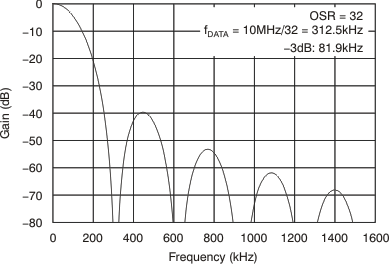JAJSIN4D October 2003 – February 2020 ADS1204
PRODUCTION DATA.
8.1.1 Filter Usage
The modulator generates only a bitstream, which does not output a digital word like an A/D converter. In order to output a digital word equivalent to the analog input voltage, the bitstream must be processed by a digital filter.
A very simple filter, built with minimal effort and hardware, is the sinc3 filter shown in Equation 2:

This filter provides the best output performance at the lowest hardware size (for example, a count of digital gates). For oversampling ratios in the range of 16 to 256, this is a good choice. All the characterizations in the data sheet are also done using a sinc3 filter with an oversampling ratio of OSR = 256 and an output word width of 16 bits.
In a sinc3 filter response (see Figure 32 and Figure 33), the location of the first notch occurs at the frequency of output data rate fDATA = fCLK / OSR. The –3-dB point is located at half the Nyquist frequency or fDATA / 4. For some applications, it may be necessary to use another filter type for better frequency response.
 Figure 32. Frequency Response of Sinc3 Filter
Figure 32. Frequency Response of Sinc3 Filter  Figure 33. Pulse Response of Sinc3 Filter
Figure 33. Pulse Response of Sinc3 Filter
(fMOD = 10 MHz)
This performance can be improved, for example, by a cascaded filter structure. The first decimation stage can be a sinc3 filter with a low OSR and the second stage a high-order filter.
For more information, see the Combining the ADS1202 with an FPGA Digital Filter for Current Measurement in Motor Control Applications application note, available for download at www.ti.com.
The effective number of bits (ENOB) can be used to compare the performance of A/D converters and ΔΣ modulators. Figure 34 shows the ENOB of the ADS1204 with different filter types. In this data sheet, the ENOB is calculated from the SNR as shown in Equation 3:

 Figure 34. Measured ENOB vs OSR
Figure 34. Measured ENOB vs OSR In motor control applications, a very fast response time for overcurrent detection is required. There is a constraint between 1 µs and 5 µs with 3 bits to 7 bits resolution. The time for full settling is dependent on the filter order. Therefore, the full settling of the sinc3 filter needs three data clocks and the sinc2 filter needs two data clocks. The data clock is equal to the modulator clock divided by the OSR. For overcurrent protection, filter types other than sinc3 might be a better choice. A simple example is a sinc2 filter. Figure 35 compares the settling time of different filter types. The Sincfast is a modified sinc2 filter as Equation 4 shows:

 Figure 35. Measured ENOB versus Settling Time
Figure 35. Measured ENOB versus Settling Time For more information, see the Combining the ADS1202 with an FPGA Digital Filter for Current Measurement in Motor Control Applications application note, available for download at www.ti.com.